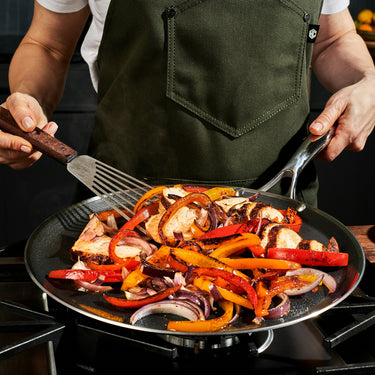Here's Exactly Why You Need A Griddle Pan

There comes a time in every cook’s kitchen-stocking journey when it’s time to go beyond your average skillets and saucepans. Sure, you’ve mastered the finesse of a rolled omelet in a small nonstick skillet, or bubbled your way through bolognese in a large pot, but until you’ve explored the myriad dishes that can be made on a stovetop griddle pan, well, can you really say you’ve cooked?
But in the name of all obsessive cooks who want to master dishes like lacy Breton galettes, perfectly crispy lentil dosas, and—the forever crowd-pleaser—sizzling fajitas, we make this plea: Get yourself a griddle pan now.
A griddle pan is a flat, wide pan that has slightly sloped edges, which allows for a greater surface area and even heat distribution than a skillet or saucepan. These shallow sides also make it easier to flip griddled food and—crucially—prevent batter or melted bacon grease from dripping off. Soon, you’ll be flipping batches of fluffy pancakes like a short-order cook. Often square or rectangular, HexClad’s griddle pan is round, which allows the pan to fit snugly over a gas, electric, or induction burner.
The word griddle is believed to date back to 13th-century Anglo-French, referring to a shallow frying pan. This style of flat, shallow-edged pan is common the world over—pans similar to griddles are known as a plancha in Spanish cuisine or a teppan in Japanese teppanyaki cooking. A comal, used in Mexican and Central American cooking to make tortillas is similar to a griddle, too.
For even cooking on a griddle, it’s key that the surface gets equally hot before you begin pouring batter or searing a steak. So, no matter what you’re cooking up on your griddle pan, be sure to preheat your griddle pan over medium or medium-high heat before adding any fat or food.
Though the names are similar, a griddle pan is different than a grill pan. The latter mimics the ridges of a gas- or charcoal-powered grill, allowing cooks to get a signature grill pattern on their food. A griddle, meanwhile, offers a flat cooking surface to evenly sear and sauté.
Here are a few more reasons we love griddles for every meal of the day:
Reason #1: Griddles are great for batters
Batter-based recipes like crêpes and galettes (crêpes’ savory cousin), dosas, and American-style pancakes all improve when cooked on a uniformly flat, hot surface. While a skillet will work, its sloped sides will cause uneven heat distribution.
Reason #2: Griddles allow you to maximize burner space
Using a griddle pan over a gas stove or an induction stove increases the surface area you can work with. Big batch fajitas? No problem. Want to make a full English breakfast? A griddle pan can do that, too. We suggest keeping the mushrooms and tomatoes to one side, the sausages and back bacon to the over, and crack the eggs into the middle, then serve the whole thing family-style. Grab your griddle pan for Saturday morning pancakes and weeknight grilled cheeses for the whole family, too.
Reason #3: A nonstick griddle pan is a breakfast workhorse
Here’s a nonexhaustive list of all the ways you’ll use a nonstick griddle pan for breakfast: pancakes, French toast, fried eggs, breakfast sausage, bacon. Bonus points for cooking all the ingredients for a breakfast burrito on the griddle, before wrapping them up in a flour tortilla and crisping it on the griddle in melted butter. (You’re welcome.) If you’re making homemade English muffins, you’ll need a griddle for those, too.
Reason #4: For even sears, there is no better pan
When more of a steak (or pork chop or zucchini, or whatever it is you want to sear) hits a hot surface, that means a bigger proportion of the ingredient will get a crispy, perfect crust. This is due to the Maillard reaction, which occurs when high temperatures cause the sugar molecules and amino acids in the proteins to interact and release complex flavors and aromas. Put simply: more food touching the hot cooking surface results in a tastier, evenly golden sear. (Pro tip: drying whatever you plan to sear extra well will make achieving a good sear easier.) Try this out with grilled cheeses, quesadillas, and other cheese-filled delights.
Reason #5: If you’re cooking a burger indoors, the griddle is the way
First, let’s dispense with the myth that burgers can be cooked in the oven. Okay, good. Often, a nonstick skillet or grill pan will be employed for cooking up a batch of burgers. Instead, swap those out for the griddle, which evenly cooks the patty (see above) for a superior crust. And if you’re going for a smash burger, a griddle offers you the perfect, steady surface against which to press down. Once the meat is cooked, safely wipe or pour off any grease, then use the still-hot pan to toast the buns.
After all that cooking, you might be wondering: How do I clean a griddle pan?
After cooking, let your griddle pan cool down completely. For a nonstick griddle pan, either wash it by hand with a gentle soap and a non-abrasive sponge, or, if it’s a HexClad griddle pan, you can pop it right into the dishwasher. For a cast-iron griddle pan, you’ll want to follow best practices for cast-iron, which means no abrasive sponges or cleaners. Wipe any residue and bits of food off the surface, then gently clean with a soft sponge and a few drops of dish soap. Dry immediately.





